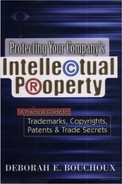Protecting Your Marks
Because lost marks cannot be revived, companies must be vigilant to protect against misuse of their marks that can lead to loss of rights. Following are some tips to promote proper use of marks:
Marks should be used as adjectives, not as nouns. Marks used as nouns run the risk of becoming generic. Thus, it is acceptable to say ''DRAMAMINE® pills prevent motion sickness'' and risky to say ''Dramamine is a motion sickness remedy.'' Famous marks are allowed some latitude, so the well-known jingle ''Have you driven a Ford lately?'' is permissible because of the long-standing fame of the FORD® trademark.
Marks should not be used in the possessive or plural form. Thus, saying ''Give me some dramamines'' may convert the mark into a generic word.
Marks should be displayed prominently in text. Many users capitalize the entire mark or display it in different font size or style from the surrounding text to draw attention to the fact that the word or matter is being used as a trademark.
Marks should be displayed with the appropriate notice (®for registered marks and TM or SM for unregistered marks). The notices show that the word or symbol is being used as a trademark. Because advertising material and brochures can appear cluttered if the registration notice is repeated numerous times, it is acceptable to use the notice the first time the mark is used and then omit it in subsequent uses in the copy.
A notice should appear on the product or material that ''XXX® is a registered trademark of ABC, Inc.'' The notice can be placed unobtrusively at the end of advertising copy in fine print.
Marks should be used consistently. Continually changing typeface, script, or presentation creates consumer confusion and may lead to abandonment of a mark. Perhaps the most famous mark in the world, COKE® , has been consistently displayed in a stylized script fashion for years, and consumers the world over have come to instantly recognize the script style. Companies should endeavor to create a unified image for their goods and services. Constant revisions to trademarks undermine this goal.
Many companies with significant trademark inventories implement trademark compliance policies to educate their employees and those the company does business with about proper use of the company's marks. In some instances, a trademark compliance officer is appointed, and all advertising copy or other materials that display the mark must be approved by this officer before being released or disseminated. Companies also provide samples of their marks to others to ensure that they use the proper version of marks and not some modified version. See Figure 5-1 for a sample trademark compliance policy.
To ensure that others are not infringing on the company's marks, employees should be urged to monitor relevant trade journals, other publica- tions, and trade shows to determine whether the company's marks are being infringed or misused. Many companies subscribe to a clipping service to locate uses of their marks. Similarly, competitors' Web sites should be visited periodically to check for infringing uses. Customers and business partners who are allowed to use the mark should be provided with usage guidelines, and their advertisements and Web sites should be checked to make sure they are displaying the company's marks properly.
